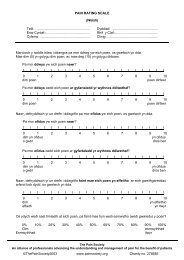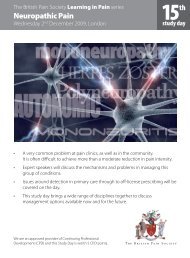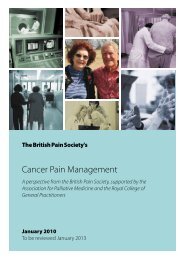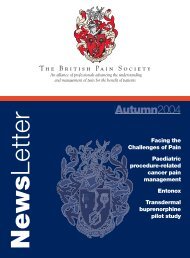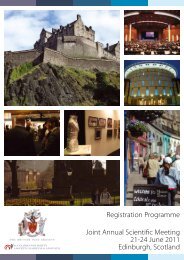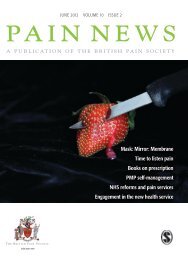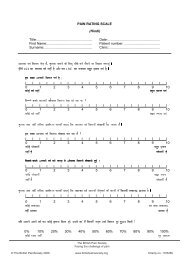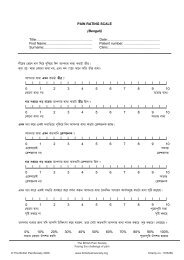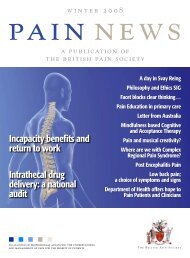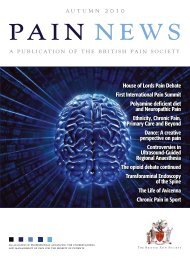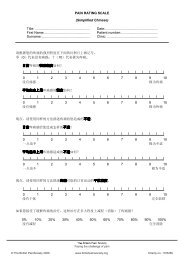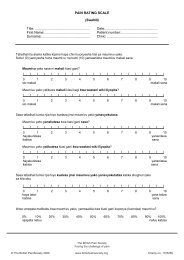Summer 2010 - The British Pain Society
Summer 2010 - The British Pain Society
Summer 2010 - The British Pain Society
You also want an ePaper? Increase the reach of your titles
YUMPU automatically turns print PDFs into web optimized ePapers that Google loves.
and “like having a blow torch on<br />
my skin”. I imagine you will have<br />
come across this sort of thing fairly<br />
commonly. But just take a moment<br />
to think about the words and what<br />
the pictures that go with them<br />
might be. Bear in mind that those<br />
pictures are going to be faster,<br />
unchecked and more powerful.<br />
If every time I have a pain I have<br />
one of these pictures that’s what<br />
I’m going to react to first and the<br />
anxiety kicks in and a whole lot of<br />
other things with it.<br />
Semiotic pain research revealed<br />
that there were five basic areas<br />
where the pain impacted on<br />
people. Firstly there was a huge<br />
impact on their self-image in<br />
terms of their personal worth,<br />
their strengths and their personal<br />
agency in life. Ideas about where<br />
the pain was coming from very<br />
rarely seemed to have any basis in<br />
fact. <strong>The</strong>y constructed their images<br />
based on other experiences in life,<br />
with very little resemblance to any<br />
anatomical details or pathology.<br />
<strong>The</strong> issue of locus of control was<br />
always interesting with patients and<br />
as expected there was often the<br />
idea that, the doctor was in charge.<br />
Other people who had always felt<br />
they were in control found it very<br />
difficult to give up that control<br />
to other people. Patients can<br />
also express pain in kinaesthetic<br />
terms like different temperature,<br />
sensation, texture or weight – “my<br />
leg has become a lot heavier” - and<br />
visual ones such as being a<br />
particular colour or a particular<br />
shape.<br />
Using imagery in therapy<br />
At Bronllys we find it very useful<br />
to use images as ways of helping<br />
people to manage the experience<br />
of pain. If you can change the<br />
image you can change the<br />
experience, and this can have a<br />
very powerful impact. It is a very<br />
useful source of healing if we<br />
can give people a more adaptive<br />
meaning to their experience.<br />
People get some very strange ideas<br />
of how their bodies work: “you’ve<br />
got some notches in the middle of<br />
each side and that just locks up”,<br />
and misinterpret what doctors tell<br />
them: “Dr T, at the pain control,<br />
he said there’s so much where<br />
they’ve cut into the spine the nerve<br />
endings they’re just jumping”. Now<br />
I’m sure Dr T wouldn’t have said<br />
this but this was what was heard.<br />
Physicians have to use metaphors<br />
when explaining things to patients<br />
but the danger is that the metaphor<br />
becomes concrete for them.<br />
Imagery can be used to create<br />
a better understanding between<br />
clinician and patient. I find pain<br />
drawings very useful because<br />
they tell me so much about the<br />
patient’s experience and distress.<br />
<strong>Pain</strong> is very multidimensional not<br />
just in terms of words but also<br />
the visual elements for different<br />
individuals. Some images of pain<br />
can even introduce a spiritual<br />
element e.g. martyrdom and this<br />
may be a powerful dynamic for<br />
some. Historical perspectives on<br />
pain are fascinating in this respect.<br />
<strong>The</strong> concept of pain as in the hands<br />
of the Gods is probably the highest<br />
form of an external locus of control.<br />
Should we then be making a point,<br />
as part of clinical assessment, of<br />
asking people to describe their<br />
pain, not just in words but in<br />
pictures? Asking something on the<br />
lines of explain what I would see if<br />
I took a photograph of your pain or<br />
indeed one that represented your<br />
life? That is very effective shortcut<br />
to finding out a lot; people put their<br />
priorities into their ‘photographs’.<br />
Should we be making more out of<br />
pain diagrams than simply getting<br />
an idea of the distribution of pain?<br />
Should art play a greater part in<br />
pain clinics? Given that it has this<br />
immediacy for people and can be<br />
very therapeutic in itself.<br />
To quote Epicetus, the famous<br />
Greek Stoic philosopher: “Men are<br />
disturbed, not by things, but by<br />
the view which they take of them.”<br />
So pain may be what the patient<br />
says it is, what the patient sees it as<br />
or how they move with it. It is up<br />
to us to find out what that image<br />
really is and, if we can to use it and<br />
other images, for good.<br />
<strong>Pain</strong>ting over the<br />
cracks: creativity<br />
when art and medicine<br />
collide<br />
Dr Diana Brighouse<br />
Southampton General Hospital<br />
Throughout my career as a pain<br />
doctor and psychotherapist and<br />
now in my final year of a fine art<br />
degree I have been looking at<br />
medicine as a healing art.<br />
<strong>The</strong> Intertextual Space<br />
I would like to discuss the wider<br />
concepts of art and medicine and<br />
firstly I would like to explain the<br />
concept of the intertextual space.<br />
<strong>The</strong> intertextual space is sometimes<br />
called the interpersonal space but<br />
that’s not strictly accurate. To put it<br />
simplistically, the intertextual space<br />
is the third space where something<br />
is created in the interaction<br />
between subject and object. That<br />
subject and object might be two<br />
people, but might be a person and<br />
a piece of literature, music or visual<br />
art, or a landscape. That is the place<br />
where creativity occurs, where the<br />
healing art of medicine occurs, and<br />
where art and medicine collide.<br />
Public space art<br />
<strong>The</strong>re is a difference between<br />
public space art and art therapy<br />
and these are quite different things.<br />
In the UK art therapy only exists<br />
as a tiny part of the mental health<br />
sector and in palliative care but<br />
is otherwise virtually unavailable.<br />
Public space art on the other hand<br />
is something we’re all exposed to<br />
every day. It’s not just the visual<br />
arts but includes architecture, the<br />
performing arts and music e.g.<br />
there is much literature about<br />
narrative and writing therapy –<br />
getting patients to write about bad<br />
experiences can be a powerful of<br />
way of getting into their world.<br />
Drama therapy is used quite a lot in<br />
adolescent mental health but not to<br />
my knowledge in any pain clinics.<br />
<strong>The</strong> most comprehensive body of<br />
knowledge about art in medicine<br />
can be found in the Arts Council of<br />
England 2004 report “Arts in health:<br />
a review of the medical literature”<br />
edited by Dr Rosalia Staricoff and<br />
reviews 400 papers. It is available<br />
online at<br />
http://www.artscouncil.org.uk/<br />
publication_archive/arts-in-health-areview-of-the-medical-literature/<br />
Some of the most compelling<br />
evidence put forward for the<br />
beneficial effect of “art” is in the<br />
study of the environment on<br />
rates of healing and recovery.<br />
<strong>The</strong> implications of this for the<br />
architecture, design, decoration and<br />
setting of healthcare facilities cannot<br />
be underestimated. <strong>The</strong>re are some<br />
visionary examples of new hospital<br />
builds inspired by this principle<br />
but nearly all are in the US. We do<br />
have some purpose-built wards,<br />
one of the most famous being the<br />
Bart’s breast cancer unit. <strong>The</strong>re<br />
is evidence of a reduced length<br />
of stay in medical wards just by<br />
changing the environment, with<br />
reduced analgesic requirements.<br />
PAI N N E W S S U M M E R <strong>2010</strong> 49




